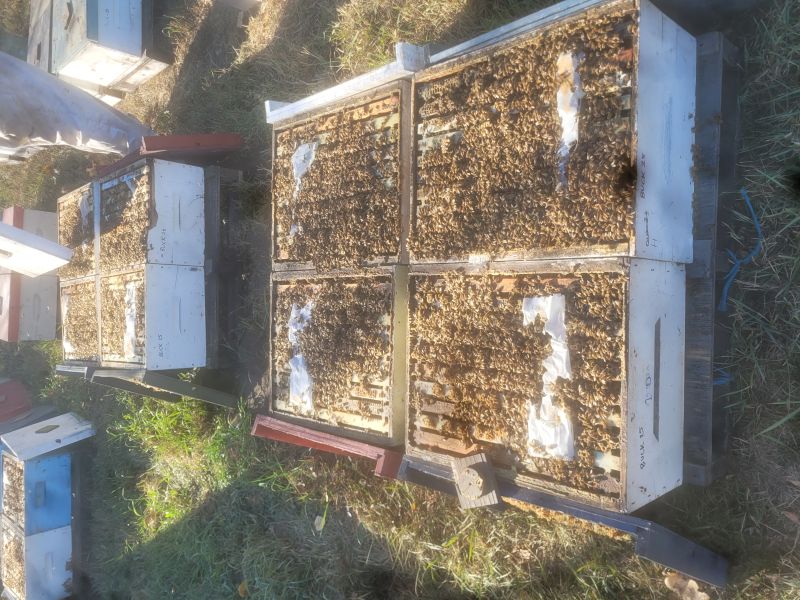· By Angela Seto
Getting ready for the bees' journey out west!

What's new on the farm:
During most of the summer, our hives are spread out in groups of 40 across many farmers' fields. We call these "outyards".
We do this so that there is enough food for each hive, and not too much competition for resources.
But now it's getting colder and the flowers are done blooming. The bees are no longer foraging for food, and are getting ready for winter.
So it's the perfect time to bring all the hives back to our home yard.
Every fall, we move our hives from Saskatoon to Vancouver Island.
This is because winter is milder there, which is easier on the hives.
It also means that the spring starts earlier for the bees too. They get access to fresh nectar and pollen earlier than in Saskatoon.
To get ready for the move, we bring the bees back from all our outyards so they are all in one spot. That makes it simpler when we load them on a truck for Vancouver Island.
We start to do this once the weather gets cold, when the temperatures are below 10°C/50°F. It's not fun working outdoors in the cold, but it's the best time to move bees.
That's because bees also don't like to work outdoors in the cold, so they stay tucked in their hives.
We go to each yard, and load up all 40 hives onto our box truck.
This is a pretty physical job as we are doing a lot of moving and stacking by hand.
Then we drive the box truck back to our home yard.
Fortunately, we have a forklift at the home yard which gives our backs a break.
The forklift can only drive in dry, flat ground. And sometimes, like this past weekend, we get an inch of rain!
Which means the farm yard is soggy and muddy.
In times like that, we will put forks on our tractor and try to unload that way. It's a bit harder than using the forklift, but we make do with what we've got!
We repeat those steps over and over again until all the hives are back in our home yard.
This year, we have close to 800 hives going into winter. So there are quite a few trips to bring them all back.
Once all the hives are back home, we will get them inspected by the provincial apiarist. They need to verify that the hives are healthy and free of diseases and Varroa mites.
This is to ensure that we aren't spreading anything to other beekeepers when we bring all the hives to Vancouver Island.
We have our inspection this Friday - wish our bees and us good luck!
In the Kitchen
You might think that since we have a farm, we have lots of space for our food kitchen!
In reality, we actually rent out a tiny (700 square foot) commercial kitchen in the city.
Over the past year, our kitchen has gotten so busy!
We've gone from 1 to 3 honey creaming machines and increased our caramel production.
And as we packaged more honey and caramels, we started to run out of room with all the boxes, jars, honey barrels, and shipping supplies.
(You wouldn't believe how much of our space our biodegradable packing peanuts take up.)
Because of all your amazing support, we’re moving to a bigger kitchen in November!
We’re really excited (and a little sad to leave our old space). This new one will make a big difference.
Our new space will allow us to add more honey creamers. This means we can pack more honey while keeping our small batch production methods.
We'll also be able to try more recipes and add new products.
It will also mean we will have more space to add more staff to help us pack and ship out orders faster!
Without you, this would not be possible. Thank you for helping our family business grow. Every single order and kind word means so much to us.
It's truly a dream to be able to do this for a living and share the amazing honey our bees make with people who value what they eat like we do!
Honey-Dijon Salad Dressing
It was Canadian Thanksgiving this past weekend, and my friend and I shared cooking duties for our shared family Thanksgiving meal.
One dish I was in charge of was a Thanksgiving slaw.
To dress the salad, I adapted a recipe from The Kitchn with honey. The sweetness helps cut the acidity of the mustard and apple cider vinegar.
This recipe was so fresh and light with the crunchy cabbage. It was so easy to throw together, I think I'll be making this throughout the year.
Ingredients:
- 1/2 medium red onion (finely chopped)
- 1/3 cup vegetable or olive oil
- 1/4 cup apple cider vinegar
- 2 tablespoons honey
- 4 teaspoons Dijon mustard
- 1/2 teaspoon kosher salt
Directions:
Whisk all the ingredients together. Let it sit for 10 minutes before dressing your salad so that the red onion mellows out and the flavors begin to marry.
This is a perfect recipe for a slaw or something more sturdy like kale salad. If you want to try the Thanksgiving slaw that I made with this, check the link below!
Recipe adapted from The Kitchn.
